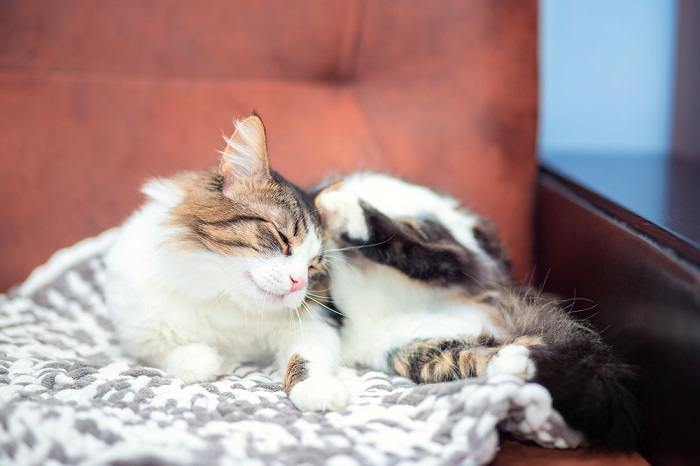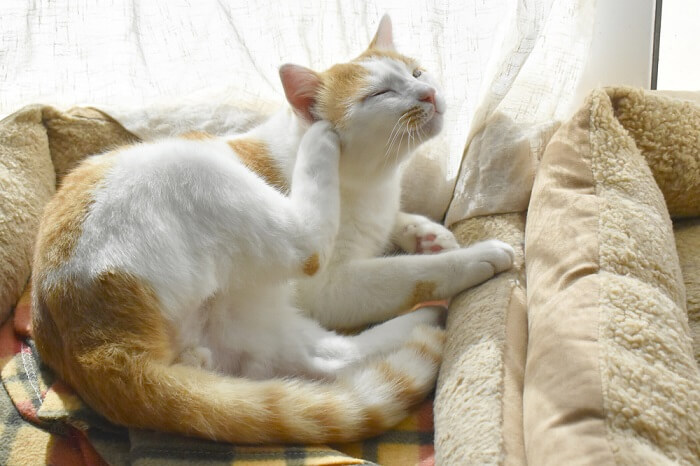
Frontline spray is a topical application spray manufactured by Boehringer Ingelheim (formerly Merial) that is used to kill fleas and ticks, as well as provide prevention against infestations by fleas and ticks and the diseases they cause.
In this article, you’ll learn what Frontline spray for cats targets, how it differs from regular Frontline spot-on products, potential side effects, and some frequently asked questions.
Quick Overview: Frontline Spray for Cats

About Frontline Spray for Cats

Frontline Spray quickly kills adult fleas and ticks, as well as chewing lice.
Like the traditional Frontline spot-on products, Frontline spray’s active ingredient is fipronil. Fipronil is a phenylpyrazole antiparasitic agent, and is technically classified as a pesticide. In invertebrates (including insects like fleas and arachnids like ticks and mites), it interrupts GABA-regulated nerve channels, causing neurologic overexcitement, disruption, and death.
However, unlike the spot-on products, like Frontline Plus and Frontline GOLD, Frontline spray is not applied to a single spot at the base of the neck. In the case of Frontline Spray for cats, the product is applied more liberally depending on a pet’s weight, in several places and worked into the fur coat to ensure wide coverage.
Also Read: How To Get Rid Of Fleas On Your Cat
What Does Frontline Spray Do for Cats?

Frontline Spray kills all adult fleas and ticks on contact, so it’s a good choice if a cat has a heavy infestation.
Frontline Spray contains only fipronil, which means that it doesn’t provide as much prevention coverage as the newer spot-on product innovations Frontline Plus and Frontline GOLD.
Fipronil kills all life stages of ticks, including the brown dog tick (Rhipicephalus sanguineus), American dog tick (Dermacentor variabilis), lone star ticks (Amblyomma americanum), and deer ticks/black-legged ticks (Ixodes scapularis). It is used to treat tick infestations and prevent reinfestation.
As a flea control product, fipronil can only kill the adults. Since it doesn’t contain an insect growth regulator like (S)-methoprene or pyriproxyfen like Frontline Plus or Frontline GOLD, Frontline Spray doesn’t have the ability to target flea eggs or larvae.
This does mean that eggs and larvae may still develop into adult fleas, so it may be possible to see new adults emerge after a couple of weeks of initially killing the original adult flea infestation.
Frontline spray is effective against chewing lice.
An advantage of Frontline Spray is that it does kill all adult fleas and ticks on contact. The spray is applied over the cat’s entire body (versus just one spot like the spot-on products, where it may take 24 hours for the product to spread throughout the oils on a cat’s skin). The spray may be faster and more effective at initially killing an active infestation of fleas or ticks.
Also Read: The 6 Best Flea Shampoos For Cats
Another potential advantage of Frontline Spray is that, according to the manufacturer, it can last for up to eight weeks in cats for treatment and prevention of fleas. However, for cats that suffer from flea allergy dermatitis (an allergic response to flea saliva), the manufacturer recommends using monthly. Adequate coverage against ticks also generally requires monthly use.
Frontline Spray for cats is considered waterproof, but the manufacturer does recommend waiting 48 hours before bathing, and to use a soap-free shampoo.
Following application of any Frontline product, it’s important to note that because fipronil causes neurologic overexcitement in the flea prior to killing it, more fleas may become visible and active following application of the product.
It’s also important to note that Frontline does not treat or prevent intestinal parasites or mosquito-borne heartworms in cats.
Side Effects of Frontline Spray for Cats

Frontline Spray is safe and effective, and has few side effects when used as directed.
When used properly, side effects of Frontline products are uncommon. Frontline products generally are only labeled for cats 8 weeks of age or older in the US.
Due to the ability to cater the spray’s dosage amount to patient size and weight, some manufacturer labeling does indicate that the spray specifically can be used in kittens as young as 2 days old. However, it is important to note that this is only found on some non-U.S. labeling. If you have a kitten less than 8 weeks old, make sure to check with your veterinarian before using Frontline Spray.
The most commonly reported effect for Frontline products is a temporary irritation at the application site. Red, irritated skin has also been reported, but is considered rare and depends on individual sensitivities. If this occurs, it is more likely a kitty has a hypersensitivity or allergy to fipronil.
Also Read: Cat Doesn’t Chew Her Food and Throws Up: When To Worry?
While Frontline products should never be ingested, fipronil generally appears to have a low potential for toxicity both topically and even if accidentally ingested.
However, the products are very bitter tasting. If a kitty were to lick recently applied Frontline off either themselves or a housemate, the bitter taste alone can lead to excessive drooling, agitation, and sometimes even vomiting.
According to DVM360’s article “Toxicology Brief: The 10 most common toxicoses in cats,” this effect is typically not a true toxicity, but a sometimes dramatic reaction to the bitter taste. Providing milk or liquid from a tuna can help resolve the signs in short order.
Unlike with the spot-on products where the single dose can be placed at the base of the neck where a kitty can’t reach to lick it off, it is generally more challenging with the spray to reduce the risk for a kitty licking the product off, owing to the need for the product to applied to the whole fur coat and worked into the skin across the whole body.
This also presents a challenge for multiple cat households where lots of co-grooming occurs. Compared to the spot-on, it would be even more important to separate housemate kitties for up to 24 hours after application to allow the product to fully dry.
Although in many cases Frontline products for dogs should not be used on cats, the spray is labeled for use in both cats and dogs. This is largely because the dosing can be specifically catered to the size of the pet.
If you have any concerns for potential toxicity, even if you think your kitty might have just licked some Frontline off their fur and is having a bitter taste reaction, it is always best to contact your veterinarian, the ASPCA Animal Poison Control Center (1-888-426-4435), or Pet Poison Helpline (1-855-764-7661) immediately for further advice.
Lastly, topical products like Frontline have been known to cause skin and eye irritation in people. It is best to wear disposable gloves when applying the spray and to wash your hands after.
Also Read: Flea And Tick Medication Poisoning In Cats
Frontline Spray for Cats Dosage

Wet the coat with the spray, and work it through the fur down to the skin.
Frontline Spray is dosed based on the weight of the cat it’s being applied on. The label on the spray bottle does include a weight-based dosing chart to refer to for both cats and dogs.
It’s important to note here that the spray cannot be used in a single application spot at the base of the head the way the spot-on products can be used. Spot-on products have a carrier agent that allow the drug to spread throughout the oils of the coat over about 18 to 24 hours. The spray must be used more liberally across the entire coat and body to be effective.
The dose the manufacturer recommends is two to four pumps of spray per kilogram of body weight. For an average 10-pound cat, this roughly equates to eight to 10 sprays at the low end and 16 to 20 sprays at the high end. Whether the low or high end of the range is used could depend on the burden of flea buildup or ticks seen, the length of the hair coat (long hair coats may require more applied product), and whether the goal is direct treatment to kill parasites, or for prevention.
The manufacturer recommends applying the spray from a distance of 10 to 20 centimeters (about 4 to 8 inches). The spray should be applied against the lay of the coat so that the spray can be worked down toward the skin more effectively.
According to the manufacturer, the entire coat should be wet with the spray (including the animal’s back and abdomen), after which it should be thoroughly worked through the coat, down to the skin. It should be noted that gloves should always be worn during the process and hands should be thoroughly washed after.
Comparing Frontline Spray and Frontline Spot-on Products

If you are fighting a flea infestation in the home, a Frontline spot-on product can break the flea life cycle.
When considering use of either the Frontline Spray or the Frontline spot-on products, it’s important to understand the advantages and disadvantages of each.
One major advantage of Frontline Spray is fast-acting with a faster kill time for adult fleas and ticks, owing to the product being directly applied across the entire body. While the spot-on products like Frontline Plus and Frontline GOLD can start to work within four hours and 30 minutes respectively, their full effects to kill 100% of fleas and ticks may still take 12 to 18 hours as the spot-on product spreads over the skin.
Frontline Spray is also far more cost-effective, especially since it can be used on both dogs and cats in a multiple pet household.
Also Read: Common Skin Problems In Cats: Causes and Treatments
There are a couple of disadvantages to using Frontline Spray over one of the spot-on products.
The first is that the Frontline Spray does not directly treat all life stages of the flea (eggs and larvae) as it does not contain an insect growth regulator ingredient. This means that after spraying a cat with an active flea infestation, more fleas are likely to appear a couple weeks later. This will take longer for an active infestation of the home to get under control and extra diligence should be taken toward treating the home environment.
The second disadvantage is in the application process. Keeping a kitty still for a single spot-on application is feasible in most cases, though some kitty parents even have trouble with this. Generally, applying a spray liberally to a cat’s body and needing to work it into the fur coat is intensive and many grown cats may not sit still well for it.
Application is also generally messier, requiring gloves and possibly keeping a kitty that has had the spray recently applied in a confined area like a bathroom for at least 24 hours until the spray fully dries to prevent it from ending up on upholstery and furniture.
While fipronil is considered a safe product for use in cats, application of the spray does introduce a lot more variation in dose for a cat, making it easy for too much (or not enough) spray to be applied. A pet parent must estimate the number of sprays to use based on weight and other factors. This is different from the single measured dose of a spot-on product.
Also Read: Cat Fleas: Identification, Life Cycle, and Treatment
If your kitty is heavily infested with fleas or ticks, it’s still important to review the dosing chart guidelines to make sure not to apply far more sprays of product than are necessary.
Lastly, application of a full body spray does make it difficult to keep a cat from licking the product off. A spot-on product can be applied to a single area at the base of the head, which is an area a cat cannot reach to lick the product off.
The Frontline product is not intended to be ingested and instructions do indicate to avoid getting in a pet’s eyes or mouth. A bitter taste response involving excessive drooling (hypersalivation) more likely to occur with use of the spray product in a cat.
Conclusion

Frontline Spray is cost effective because it can be used on both dogs and cats.
Frontline Spray is an effective flea and tick control product and is a cost-effective way to address a flea and tick infestation, especially if a kitty has a heavy burden of parasites that need to be killed quickly. Also, some manufacturer labeling indicates that Frontline Spray can be used safely in very young kittens (non-U.S. labeling only; consult your veterinarian before using if your kitten is less than 8 weeks old).
However, Frontline Spray doesn’t address all stages of the flea life cycle and compared to a spot-on product, the spray presents a greater risk for bitter taste reactions from a cat licking the product off, and may involve a more difficult application process.
Also Read: The 7 Best Cat Treats For Kittens
Frequently Asked Questions
Is Frontline Spray safe for cats?
Frontline’s main ingredient, fipronil, has long been considered to be a safe ingredient for use in cats. Frontline Spray is approved for use in both dogs and cats. It is important to note however, that safety also implies proper use of the product as instructed.
Because Frontline Spray must be applied throughout the entire haircoat and the cat’s body, this does increase the risk for a cat to lick the product off after application, leading to a bitter taste response.
How does Frontline Spray work on cats?
Frontline Spray works to kill adult fleas, ticks, and chewing lice directly on contact. With it being applied throughout the entire hair coat, it is effective at addressing heavy burdens of these parasites quickly in cats.
Frontline Spray however does not address all life cycles of the flea, including the eggs and larvae the way that Frontline Plus and Frontline GOLD do. This does mean that adult fleas may be noted again in a couple of weeks when the eggs hatch and the larvae develop into new adults.
How do you apply Frontline Spray to cats?
Frontline Spray is applied liberally to a cat’s entire hair coat and body. The amount of pumps of spray used depends on the hair coat length of the kitty, how bad the flea or tick burden is, and whether the focus is on treatment or prevention of fleas and ticks.
The dose is two to four pumps of spray per kilogram of body weight. For an average 10-pound cat, this averages to about eight to 10 to 16 to 20 pumps of spray depending on the need with more needed for longer or dense coats. The Frontline Spray bottle contains a dosing chart to help guide the pet parent on the most appropriate dose.
The spray should be applied against the lay of the pet's hair and then worked thoroughly into the pet's coat down to the skin until the hair coat is wet with the product. You should always wear household latex gloves when applying this product.
How often can I spray my cat with Frontline?
If applying for both fleas and ticks, a monthly application is needed. If applying for only the intention of fleas, the manufacturer indicates that the product can be extended out to every eight weeks in cats.
The one exception to this is for cats that suffer from flea allergy dermatitis (FAD), which is an allergy to flea saliva. The manufacturer recommends using the product every 30 days for these kitties.








i have a general vet . in addition I take my cat to a speciality vet clinic for what we thought was chin acne. Started when she was 4. slowly got worse. She is 11 now and absolutely NOTHING gets rid of it.I look at pics on line of other cats and not one of them looks half as bad as my cat. she is on 25 mg of Atopica for a year now. Nothing. they have taken skin scrapings .blood. etc. everything and it never lets up. Black pieces evryday. If I take it off. just as bad next day. She does not scratch at it, eats fine, plays..all is fine.Chin is black and moving up to where cheek whiskers grow. Her eyes drain and drip all the time also. In past years that has been cleared up temporairly with steroid ointment with a 2 week covina shot. Comes right back within a week or so. At end of my wits. Getting Xtremily , impossible some days to get Atopica down her. Any suggestions at this time from you ? thank you
Hi Rhonda,
You may find it helpful to repost your question under a related medical topic, as posting under the Frontline Spray article may not be as helpful for you. You can find the article for feline acne here. Posting there may get you some more feedback.
Often, persistent feline acne is considered to be related to an allergy or immune response. The frustrating part of it is that it is often very difficult to determine the allergen or allergens causing it, or impossible to remove the allergen if it is environmental. Removal of plastic food and water bowls and replacing them with metal or ceramic bowls is the most common recommendation, but that was probably discussed with you some time ago, perhaps still leaving the underlying cause unknown.
If the allergen cannot be removed, then what you’re left with is trying to address the response in the skin. Unfortunately, this usually requires constant use of something topical or oral to manage inflammation and flare-ups, as well as secondary infections as they occur. It sounds like this is essentially what you have been doing. Our best goal is management by trying to find something that works best and continue that longterm as long as side effects are kept minimal.
Perhaps looking into the steroid ointment again is a viable long-term choice if it appeared to help and you’re having more difficulty with the Atopica. The dermatologist I assume you’re working with may also still have some additional treatment options, if you have not touched base to discuss these more recent challenges you’ve had. A food protein allergy for example is less common but possible and a dietary trial could be discussed.